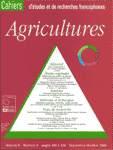Densité de semis, croissance et production de deux lignées de gombo ("Abelmoschus spp.") en Côte d'Ivoire
Résumé
The effects of sowing density on the growth and yield of two okra cultivars, Abelmoschus esculentus (L.) Moench cv Koto and Abelmoschus caillei (A. Chev.) Stevels cv Tomi, were assessed at a research station of IDESSA, Department of Crop Production, in Bouake, Cote d'Ivoire, during the 1994 rainy season. Four sowing densities were compared: D1 (0.50m x 0.50m, 40,000 plants/ha), D2 (0.25m x 1.00m, 40.000 plants/ha), D3 (0.50m x 1.00m, 20,000 plants/ha), and D4 (0.25m x 0.50m, 80,000 plants/ha). A split-plot experimental design was used with four replications. The plot size was 20m2, including a measuring plot of 3m2. Every 2 weeks, plant growth was evaluated by measuring the dry weight of stems and leaves of one plant taken from each plot; these data were used to build weight curves. Other collected data were: days to flowering (date on which 50% of the plants in a plot had been in anthesis), the height of the first fruit insertion, height of plants initially and at harvest, and yield components. Each plant in each plot was measured and the mean overall height was recorded. Data were analysed statistically and critical differences were calculated. Figures 1 and 2 show dry weight curves of cvs Koto and Tomi. Two successive growth phase peaks are shown in Figure 1: the first 30-120 days after sowing (das) characterizing normal growth; the second (120 das to the end of the cycle) could correspond to secondary growth due to the late rain that fell in Bouake during the 1994 season. In Figure 2, a slow growth phase, a peak and an accelerated declining growth phase are shown. The late phases correspond to a defoliation effect. Using the Newman-Keuls' test at the 0.05 level, density D3 (20,000 plants/ha) was best in terms of fruit production, followed by D2, D1 and D4 (Table 1). Good performance of plants with D3 sowing density (20,000 plants/ha) could be explained by low competition between them for nutritional needs. Variance analysis revealed a strong density effect, while density x cultivar interactions, were not significantly different and this shows that sowing density did not influence the expression of the parameters studied. Consequently, a comparison was made between both cultivars (Table 2).Téléchargements
Publié
1999-09-01
Comment citer
Fondio, L., Kouamé, C. N. ., Traoré, D., & Djidji, A. H. . (1999). Densité de semis, croissance et production de deux lignées de gombo ("Abelmoschus spp.") en Côte d’Ivoire. Cahiers Agricultures, 8(5), 413–415 (1). Consulté à l’adresse https://revues.cirad.fr/index.php/cahiers-agricultures/article/view/30200
Numéro
Rubrique
Articles

